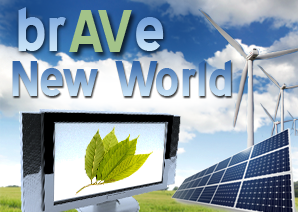Offsetting: What the AV Pro Should Know
 If you’re like me, when you first heard about carbon offsetting and carbon neutrality years ago, you rejoiced at being able to purchase a certificate that said we were doing the “right thing.” In our innocence, we figured we no longer had to feel guilty or concerned about the implications of our equipment wattage reaching the tens of thousands in a single, average-sized production.
If you’re like me, when you first heard about carbon offsetting and carbon neutrality years ago, you rejoiced at being able to purchase a certificate that said we were doing the “right thing.” In our innocence, we figured we no longer had to feel guilty or concerned about the implications of our equipment wattage reaching the tens of thousands in a single, average-sized production.
Alas, as the business world was treated to a greenwashing smackdown, we learned that offsetting wasn’t the magic elixir that evaporated GHGs* as we had hoped. Over time though, we also recognized that offsetting is still a viable element of sustainability planning when done properly. Hopefully this month I can give you a few insider tips on how to effectively offset as an operator in the (primarily Rental & Staging) professional AV industry, without incurring the furious scrutiny of the green police (not to be confused with the subject of a great Cheap Trick song).
The first thing you need to know is that offsetting IS ALWAYS the last step in a comprehensive sustainability plan. Go back through the last two years of rAVe GreenAV columns of awesomeness and study every word we have told you about how to develop this plan. And then do it. No, seriously, do it now. Because a major step in most of these plans encourages you to reduce your environmental impact before you ever think about offsetting. This usually includes sourcing as many resources locally as is humanly possible, such as labor, materials, gear and any other elements of our systems. Transportation is a big, fat producer of GHGs and can often be avoided with better planning and awareness. Your plan should also include on-site recycling, designing more energy efficient lighting, using equipment that is lighter and more energy efficient, measuring your impact… you get the idea.
OK, so I’ve harried you enough and you’ve implemented your plan. You’ve earned the right to offset. So here’s what you need to know:
- Did I mention the plan? No, in all seriousness, you need to be sure that part of your plan includes the measurement and reporting of your activity. This will prepare you for knowing how much you need to offset. You then need to determine if you are looking to offset everything, including travel of crew, the impact of equipment during a show, consumables used on-site and transporting any equipment.
- Choosing an offsetter: As of now, there is no globally (or even nationally) defined standard or compliance required for voluntary offsetting (voluntary meaning this isn’t the large corporate or government trades where you HAVE to offset what you’ve said you will). Ensuring that your money is going where you think it’s going and that the project actually is neutralizing your footprint is basically on an honor system… or at least a reliance upon watchdog organizations to blow the whistle on offenders. The good news is that there is at least one standard that assesses their participants for compliance, which is the Gold Standard. Additionally, the state of California is in the process of developing a registry of projects. Watch for other states (or even the federal government) to follow suit once this system is functioning.
- Choosing a project: Once you’ve selected a reputable offsetter to purchase credits from, it’s time to select one of their projects that will most effectively absorb the GHGs you’re producing. The most generally accepted best practice is to try to find a project that is close to where your event is taking place. If you’re a national operator or in-house company, you might want to choose a location where you do the most events, or perhaps in your headquarter city. Further, renewable energy projects are usually preferable to reforestation projects as they’re most effective at reducing GHG emissions immediately, whereas trees take anywhere from five to 15 years to begin having an effect.
If you can keep in mind that only after you have minimized travel/shipping, reduced material consumption, increased energy efficiency and made other reduction efforts, offsetting is a viable and powerful tool to help us mitigate the impact of our GHG emissions.
 *GHG = Green House Gas emissions are gasses that trap heat in the earth’s atmosphere. As determined by the Kyoto Protocol, these gasses include Carbon dioxide (CO2), Methane (CH4), Nitrous oxide (N2O), Sulfur hexafluoride (SF6), Hydrofluorocarbons (HFCs) and Perfluorocarbons (PFCs).
*GHG = Green House Gas emissions are gasses that trap heat in the earth’s atmosphere. As determined by the Kyoto Protocol, these gasses include Carbon dioxide (CO2), Methane (CH4), Nitrous oxide (N2O), Sulfur hexafluoride (SF6), Hydrofluorocarbons (HFCs) and Perfluorocarbons (PFCs).
Midori Connolly is CEO and Chief AVGirl of Pulse Staging & Events, Inc. in Escondido, California. She wrote the first-ever set of Sustainable Staging guidelines after discovering none existed. She is the vice-chair of the AV committee for the U.S. EPA’s Green Meetings Standards and regularly speaks and writes about corporate social responsibility and green practices in live events and meeting planning. Reach her at midori@pulsestaging.com



